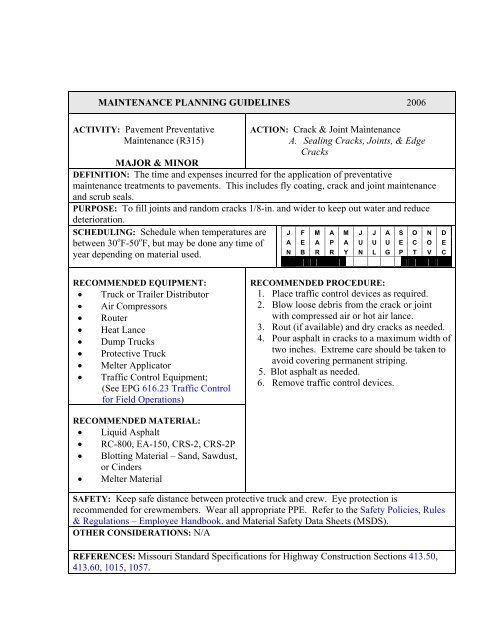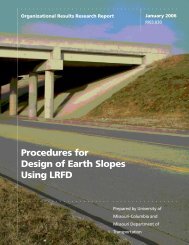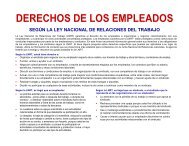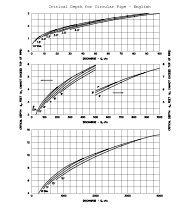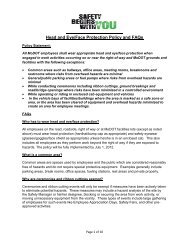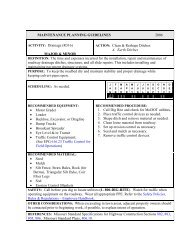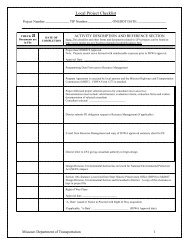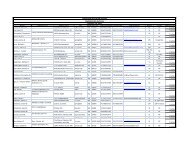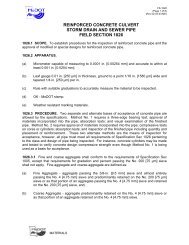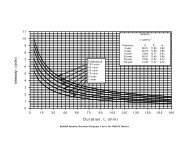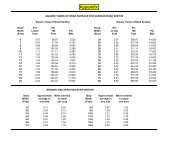A. Sealing Cracks, Joints & Edge Cracks
A. Sealing Cracks, Joints & Edge Cracks
A. Sealing Cracks, Joints & Edge Cracks
You also want an ePaper? Increase the reach of your titles
YUMPU automatically turns print PDFs into web optimized ePapers that Google loves.
MAINTENANCE PLANNING GUIDELINES 2006<br />
ACTIVITY: Pavement Preventative<br />
Maintenance (R315)<br />
ACTION: Crack & Joint Maintenance<br />
A. <strong>Sealing</strong> <strong>Cracks</strong>, <strong>Joints</strong>, & <strong>Edge</strong><br />
<strong>Cracks</strong><br />
MAJOR & MINOR<br />
DEFINITION: The time and expenses incurred for the application of preventative<br />
maintenance treatments to pavements. This includes fly coating, crack and joint maintenance<br />
and scrub seals.<br />
PURPOSE: To fill joints and random cracks 1/8-in. and wider to keep out water and reduce<br />
deterioration.<br />
SCHEDULING: Schedule when temperatures are<br />
between 30 o F-50 o F, but may be done any time of<br />
year depending on material used.<br />
J F M A M J J A S O N D<br />
A E A P A U U U E C O E<br />
N B R R Y N L G P T V C<br />
RECOMMENDED EQUIPMENT:<br />
• Truck or Trailer Distributor<br />
• Air Compressors<br />
• Router<br />
• Heat Lance<br />
• Dump Trucks<br />
• Protective Truck<br />
• Melter Applicator<br />
• Traffic Control Equipment;<br />
(See EPG 616.23 Traffic Control<br />
for Field Operations)<br />
RECOMMENDED PROCEDURE:<br />
1. Place traffic control devices as required.<br />
2. Blow loose debris from the crack or joint<br />
with compressed air or hot air lance.<br />
3. Rout (if available) and dry cracks as needed.<br />
4. Pour asphalt in cracks to a maximum width of<br />
two inches. Extreme care should be taken to<br />
avoid covering permanent striping.<br />
5. Blot asphalt as needed.<br />
6. Remove traffic control devices.<br />
RECOMMENDED MATERIAL:<br />
• Liquid Asphalt<br />
• RC-800, EA-150, CRS-2, CRS-2P<br />
• Blotting Material – Sand, Sawdust,<br />
or Cinders<br />
• Melter Material<br />
SAFETY: Keep safe distance between protective truck and crew. Eye protection is<br />
recommended for crewmembers. Wear all appropriate PPE. Refer to the Safety Policies, Rules<br />
& Regulations – Employee Handbook. and Material Safety Data Sheets (MSDS).<br />
OTHER CONSIDERATIONS: N/A<br />
REFERENCES: Missouri Standard Specifications for Highway Construction Sections 413.50,<br />
413.60, 1015, 1057.
R315 Crack & Joint Maintenance (A. <strong>Sealing</strong> <strong>Cracks</strong> and <strong>Joints</strong>)<br />
(1) Joint prior to work (2) Crew blowing out joints with heat & air<br />
(3) Crew blowing out joints with heat & air (4) Joint after being cleaned out
(5) Crew filling joint (6) Crew filling joint<br />
(7) Close up of wand filling the joint (8) Completed joints after filling:<br />
(9) Completed joints after filling:


